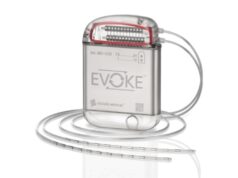A randomised, double-blind trial finds ECAP-controlled closed-loop spinal cord stimulation (SCS) statistically superior for the treatment of chronic pain, compared to open-loop stimulation. At 12-months, >83% of closed-loop patients reached the ≥50% responder threshold and >56% reached the ≥80% high responder threshold in overall back and leg pain. Presenting these results at the North American Neuromodulation Society’s (NANS) annual meeting (23–26 January, Las Vegas, USA), Timothy Deer, president and CEO of The Spine and Nerve Center of the Virginias, Charleston, USA, argued that these are “some of the best results seen within our field and any publication today”.

The study also found that the median ECAP (evoked compound action potentials) amplitude with open-loop stimulation fell below the in-clinic target when patients were outside of the clinic. Yet the closed-loop group maintained the target level of activation. Moreover, Deer acknowledged that the time spent in the therapeutic range was almost double—and significantly different—with closed-loop stimulation (95.2% vs. 47.9%), and the most frequent spinal cord activation level was six times greater in this cohort, compared to those receiving open-loop.
Speculating about the mechanics behind this spinal cord activation data, Deer said: “This would indicate to us that the activation of the ECAPs, and staying in the zone of activation, is an important issue. After nearly 50 years of not quite knowing the neural tissue response to SCS, this is the first time we can say we are activating ECAPs.” He added: “This leads to a lot more discussion for future research on the subject.”
Deer explained that the study was designed to preserve objectivity and minimise bias. Aspects of the design that were closely monitored included both the number and duration of clinic visits in both groups, as well as lead location, procedure time, while blinding was maintained. “There was no significant differences between groups,” he posited, “which is very important and can eliminate some of the confounds that can occur if one group had a different programming or time spent with the patient in that regard.”
In total, 134 patients were randomised 1:1 to the closed-loop versus open-loop arms, with the latter being the control. Fifty-nine patients in each arm remained at 12 months. Deer noted no significant differences in baseline characteristics between the two groups, yet pointed to the fact that the duration of pain in patients in both groups was long: 14 years in the closed-loop group; 11 in the open-loop group. “Previous literature suggests that if pain endures for over 10 years, response to a fixed-loop system is pretty low,” he remarked. Around 60% of patients in both groups were on opioids. And, in terms of previous back surgery, Deer said that roughly 60% of patients had back surgery, leaving 40% of the population never have undergone surgery, “which could be important later on”, he noted.
In terms of opioid reduction over time, the closed-loop group had a baseline of 80 MMEs (morphine milligram equivalents), which decreased to 45 at 12-months. According to Deer, a reduction in opioids was also observed in the open-loop group. “I think that is a very important result,” he said.
The investigators also looked at clinically important improvements in disability, quality of life, mental functioning and sleep. A statistical difference in improvement was found for emotional functioning, assessed with Profile of Mood Stats (POMS), for the closed-loop group. This population also improved on the other aforementioned patient-reported measures to a greater degree than patients receiving open-loop stimulation.
Speaking on what the future holds, Deer tells NeuroNews, “We keep seeing major innovations in the space at a very encouraging pace,” as he highlights that the need for collaboration and commitment to excellence in outcomes, which has “never been more critical”, he says.










